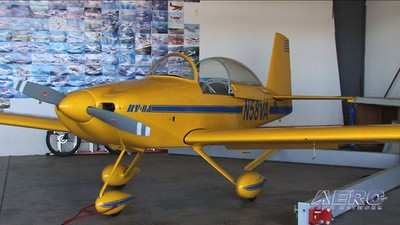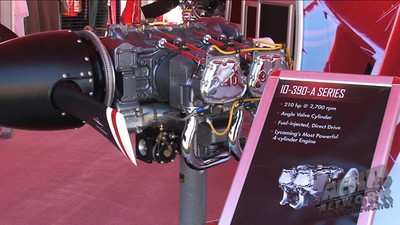Van’s Has Approved The 215HP IO-390-EXP119 Engine For The RV-7 and RV-8
Some good news from Van's for those for whom there is never enough horsepower under the cowl.

Since the introduction of the Lycoming IO-390A engine, Van's relates that some of their customers have expressed their desire to install this engine on a RV-7/7A or RV-8/8A airframe. Van’s Aircraft has recently completed an in-depth review of horsepower limitations for the RV-7/7A and RV-8/8A and is now approving the use of Lycoming’s 210HP IO-390A (YIO-390-A3B6) and IO-390-EXP119 engines on these models.
They ask that you keep the following in mind as you make your engine selection: With the 10 HP increase above the angle valve IO-360, there were concerns of the increased possibility of exceeding the Vne limitation of 200 KTAS. Van's extensive experience with the IO-390A on the RV-14A has demonstrated the engine’s true performance. The extra horsepower will result in a top speed increase. However, it will not be a significant enough change to raise a concern, providing the pilot continues to abide by the existing 168 KTS Vc (max-cruising) speed and 200 KIAS/KTAS Vne (never-exceed) speed limitations.
Should this higher-powered engine be installed, Van’s Aircraft strongly recommends that the aircraft be equipped with or upgraded to an EFIS system with an audible voice warning of Vne. Overspeed events may occur in maneuvering flight (such as aerobatics) when the pilot’s attention is turned away from the airspeed indicator. A voice annunciation, coupled with standard screen-displayed warnings, will help warn the pilot of impending danger.

Van's feels that a screen message on its own and/or audible tone warning is not as effective.
If your aircraft is equipped with an EFIS that does not have a voice warning for Vne, contact the manufacturer and request this feature to be added in the future. Note that most popular EFIS systems now allow Vne to be set up for KIAS and KTAS simultaneously, and for the RV-7/7A and RV-8/8A both values should be set to 200 KTS on systems with that capability.
Use of the IO-390A on a RV-7/7A or RV-8/8A will require modifications to the standard IO-360 angle-valve firewall-forward kit sold by Van’s. The plans supplied with your aircraft or kit will not reflect these modifications. This will result in incompatibility with certain standard firewall forward kit items that will require builder resolution. For example, the IO-390A engine cools the pistons by spraying oil on the piston skirts. This results in significantly higher oil temperatures than one will see with an angle valve IO-360. A larger oil cooler such as the cooler used on the RV-14 will need to be installed to compensate. The standard oil cooler included in the angle valve IO-360 firewall forward kit can be removed from that kit by request. The larger cooler will need to be mounted to the firewall approximately as shown in the RV-14 plans. Consequently, the installation of other firewall-forward items such as solenoids, battery box and hose routings will need to be modified by the builder
without specific plans or documentation covering the modifications. The opening in the rear baffle behind cylinder #4 that results from the deletion of the standard oil cooler will need to be blocked.

There are other modifications and alterations builders should anticipate that will be required to the existing firewall-forward kits. Van’s has not yet done a complete evaluation to compile a list of modifications, nor will they do so, soon.
Please note that Van’s Aircraft has not installed an IO-390A engine on a RV-7/7A or RV-8/8A at the factory.
Therefore, their builder technical support department may not be able to assist you in resolving issues related to your installation of this engine on the RV-7/7A and RV-8/8A. They are aware that this engine has been successfully installed by builders a number of times, and therefore are confident the modifications required are not beyond the capabilities of the builder, and members of the Van’s Aircraft community will be able to share information about their experiences. Should you install an IO-390A engine, Van's remains open to hearing your feedback.
 ANN's Daily Aero-Linx (05.06.25)
ANN's Daily Aero-Linx (05.06.25) ANN's Daily Aero-Term (05.06.25): Ultrahigh Frequency (UHF)
ANN's Daily Aero-Term (05.06.25): Ultrahigh Frequency (UHF) ANN FAQ: Q&A 101
ANN FAQ: Q&A 101 Classic Aero-TV: Virtual Reality Painting--PPG Leverages Technology for Training
Classic Aero-TV: Virtual Reality Painting--PPG Leverages Technology for Training Airborne 05.02.25: Joby Crewed Milestone, Diamond Club, Canadian Pilot Insurance
Airborne 05.02.25: Joby Crewed Milestone, Diamond Club, Canadian Pilot Insurance





